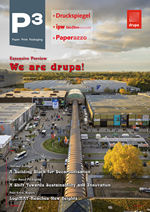NEWS
Cepi: New 2030 climate plan presents forests as golden egg
Last week, the European Commission President Ursula von der Leyen gave her first state of the union speech and proposed a revision of the EU emissions reduction target from 40% to 55% by 2030. This target is the central piece of the EU’s 2030 Climate Target Plan, together with the revised ETS state aid rules.
The Confederation of European Paper Industries (Cepi) acknowledges the 55% target compared to 1990 levels and notes that, according to the impact assessment to be released soon, the new reduction target is both economically feasible and beneficial for Europe, with the adequate policies in place.
“The target is the most significant milestone in the EU’s drive to realise its goal of becoming the world’s first carbon neutral continent by 2050. It is a challenging transition for any industrial sector but, if achieved, it will impact the food Europeans eat, the cars they drive and the homes they live in. Our sector contribute to all that with green and resilient solutions made in Europe with European technology for European consumers”, Cepi Director General Jori Ringman says.
We are already fully committed to the objective of a climate neutral Europe by 2050, as reflected in our CEO initiative published last November and the European Green Deal. Our aim is to be the most competitive and sustainable solutions provider for a climate-neutral Europe in 2050. Building on our performance so far, we are on a trajectory to further reduce our fossil emissions while increasing and diversifying the production of our bio-based goods in Europe.
Our industry has a strategic interest in being at the forefront of the decarbonisation efforts. In this race, the availability of finance will be critical. But with a supportive and stable regulatory framework, we are confident that we can reduce our emissions while increasing production in Europe and creating skilled jobs in Europe.
Finding innovative breakthrough technologies will be key to further reducing other emissions to water and air towards the Zero Emission objective and tap into industrial symbiosis to increase circularity and extract valuable resources in those emissions.
Our industry is also a central part of the EU forest-based industries, an industrial ecosystem which contributes to keeping forests healthy by fostering their ability to absorb CO2 from the atmosphere, supporting regeneration of harvested areas, safeguarding biodiversity and preserving valuable habitats as a part of active and timely Sustainable Forest Management. We also actively contribute to effective afforestation and reforestation.
The European Green Deal is based on the idea that it needs to preserve forests’ CO2 sequestration and sink as well as biodiversity but still with the possibility of harvesting wood for economic uses. EU’s sustainably managed forests can play a bigger role in enabling the EU Green Deal in many policy areas while at the same time annual carbon stock in European forests increases.
“Forests should not be seen as the golden egg to compensate for the lack of emission reductions in other sectors which are not delivering on their decarbonisation agenda – and also cannot claim the ownership of the goose. It is counterproductive, unfair and morally questionable. Having import-reliant sectors’ emissions compensated by European forests risks exporting environmental degradation and importing loss of reliance and sustainability. Possible inclusion of agricultural non-CO2 emissions to the current LULUCF sector bears that risk, too,” warns Ringman.
The carbon stock in European forests is huge: according to the European Commission, the annual emissions of all motor vehicles in the EU are equal to only 0.03% of the stock. And the stock keeps growing with the sink that is currently equal to 10% of all EU fossil emissions. The sink, as it is the rate of increasing the stock, can vary year on year but the stock has been increasing consistently in modern Europe.
“Any concerns regarding the declining carbon sink should be a signal for other sectors to accelerate their own emission reductions, as the forest-based sector has done consistently in the past decades, not a signal to hinder sustainable forest management and wood mobilisation. Passive measures like traditional forest preservation will not suffice,” added Ringman.
While climate change will indeed bring risks for the sink in terms of pest and fires, increased demand for wood does not, as sustainable forest management ensures not more is harvested than can be sustainably supplied. For example, the recent spread of the bark beetle in Central European forests indicates that relying solely on the forest sink is a risky business.
Likewise, almost as big as the forest sink in Europe, the contribution of the sectors’ low-carbon products is significant. The new 2030 plan rightly establishes a clear link between the 2030 proposed target and the Circular Economy Action Plan, it misses taking into account the substitution effect thanks to forest-based products. We believe that sustainable choices can be encouraged by the reliable information provided, which should be the focus of the upcoming Sustainable Product Policy Initiative. Cepi calls for an improved market access for recyclable and bio-based products, through a coherent product policy framework that allows for sustainable consumer choices. Cepi calls for coherence with the upcoming legislative proposal on Green Claims.
We look forward to engaging with EU policy-makers to unlock the potentials of our sector in delivering carbon reductions and value added to the European economy. EU funding for recovery and fair transition should identify pulp and paper industry as a truly green, digital and resilient part of EU economy, in a good position to contribute to the sustainable recovery of the fourteen selected ecosystems and the EU economy as a whole.








